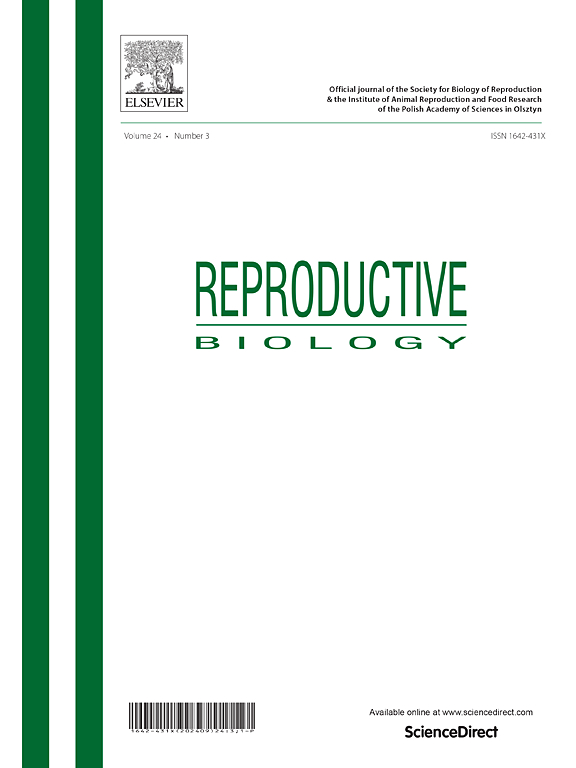用羟丙基甲基纤维素冷冻保存牛精液的质量评价
IF 2.5
3区 生物学
Q3 REPRODUCTIVE BIOLOGY
引用次数: 0
摘要
目的是评价不同浓度羟丙基甲基纤维素(HPMC)对牛精液冷冻保存的影响。采用电射精法采集7头公牛的精液,在添加和不添加甘油(G)的tris -卵黄培养基中稀释,处理如下:C: tris -卵黄+ 6 %G;T1: Tris-Egg yellow + 3 % G;T2: Tris-Egg yellow + 0 % G;T3: tris -蛋黄+ 0.5 % HPMC;T4: tris -蛋黄+ 1.0 % HPMC;T5: tris -蛋黄+ 1.5 % HPMC;T6: tris -蛋黄+ 5.5 % G + 0.5 % HPMC。样品冷冻保存于- 196°C。解冻后,通过快速耐热性试验(RTRT)、精子形态、低渗肿胀试验、质膜完整性、线粒体活性和体外受精(IVF)试验评估精子质量。RTRT结果显示,与T6组相比,对照组在0 ‘,15 ’和30 '时具有更好的运动性和活力。T6组效果优于添加0.5 %、1.0 %、1.5 % HPMC组。在45 '时,RTRT、低渗肿胀、形态学、膜完整性、线粒体活性或体外受精率均无显著差异。总之,HPMC的加入降低了精子活力和活力,但对其他低温保存参数没有负面影响。本文章由计算机程序翻译,如有差异,请以英文原文为准。
Evaluation of the quality of bovine semen subjected to cryopreservation with hydroxypropylmethylcellulose
The objective was to evaluate the effects of different concentrations of hydroxypropylmethylcellulose (HPMC) on the cryopreservation of bovine semen. Semen was collected from seven bulls by electroejaculation and diluted in Tris-egg yolk medium with and without glycerol (G) in the following treatments: C: Tris-Egg Yolk + 6 %G; T1: Tris-Egg Yolk + 3 % G; T2: Tris-Egg Yolk + 0 % G; T3: Tris-Egg Yolk + 0.5 % HPMC; T4: Tris-Egg Yolk + 1.0 % HPMC; T5: Tris-Egg Yolk + 1.5 % HPMC; T6: Tris-Egg Yolk + 5.5 % G + 0.5 % HPMC. Samples were frozen and stored at −196°C. After thawing, sperm quality was assessed using the rapid thermoresistance test (RTRT), sperm morphology, hypoosmotic swelling test, plasma membrane integrity, mitochondrial activity, and in vitro fertilization (IVF) test. RTRT results showed that the control group had better motility and vigor at 0’, 15’, and 30’ compared to the T6 group. The T6 group had better results than other groups supplemented with 0.5 %, 1.0 %, and 1.5 % HPMC. No significant differences were observed at 45’ for RTRT, hypoosmotic swelling, morphology, membrane integrity, mitochondrial activity, or IVF rates. In conclusion, the addition of HPMC reduced sperm motility and vigor but did not negatively affect other cryopreservation parameters.
求助全文
通过发布文献求助,成功后即可免费获取论文全文。
去求助
来源期刊

Reproductive biology
生物-生殖生物学
CiteScore
3.90
自引率
0.00%
发文量
95
审稿时长
29 days
期刊介绍:
An official journal of the Society for Biology of Reproduction and the Institute of Animal Reproduction and Food Research of Polish Academy of Sciences in Olsztyn, Poland.
Reproductive Biology is an international, peer-reviewed journal covering all aspects of reproduction in vertebrates. The journal invites original research papers, short communications, review articles and commentaries dealing with reproductive physiology, endocrinology, immunology, molecular and cellular biology, receptor studies, animal breeding as well as andrology, embryology, infertility, assisted reproduction and contraception. Papers from both basic and clinical research will be considered.
 求助内容:
求助内容: 应助结果提醒方式:
应助结果提醒方式:


